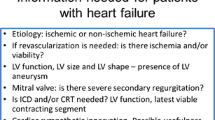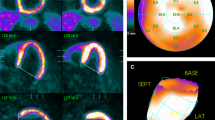Abstract
Objective
Application of the electrocardiographically (ECG) gated positron emission tomography (PET) technique with 11C-hydroxyephedrine (HED) would allow the simultaneous assessment of cardiac sympathetic and contractile functions. However, there are uncertainties regarding the diagnostic accuracy of left ventricular (LV) volume measurements using ECG-gated HED-PET. The purpose of this study was to clarify the minimal requirement of count statistics to measure LV volumes with ECG-gated HED-PET and to investigate the reliability of the measurements.
Methods
Five healthy volunteers and 11 patients with heart failure underwent a 40-min list-mode PET scan after an injection of HED (197 ± 35 MBq). The list-mode data were histogrammed into multiple sets of acquisition periods at 0.5, 1.0, 2.0, 4.0, 6.0, 8.0, 12.0 Mcount/bin and reconstructed into corresponding gated images using an iterative algorithm. The LV end-diastolic volume (LVEDV), the LV end-systolic volume (LVESV), and the LV ejection fraction (LVEF) were calculated in each acquisition period. These values were compared with those obtained by cardiac magnetic resonance imaging (MRI). Possible effects of HED retention on the accuracy of the volume measurements were investigated.
Results
Collecting less than 4.0 Mcount/bin resulted in noisy cardiac images. The lower counts resulted in underestimation in the volume measurements. Reasonably accurate volume measurements required equal to or greater than 6.0 Mcount/bin. This corresponded to 7.0 ± 1.9 min (range, 4.0–10.3 min) for the acquisition period. Volumetric results using the 6.0 Mcount/bin data highly correlated with cardiac MRI (LVEDV: r = 0.85, p < 0.0001; LVESV: r = 0.89, p < 0.0001; LVEF: r = 0.77, p < 0.01). The HED retention did not affect the volumetric results compared to the MRI volumetry.
Conclusions
The volumetric accuracy with ECG-gated HED-PET was affected by the count statistics rather than the HED retention. LV volume measurements were feasible with 10-min acquisition period for most of the patients. This technique allows the simultaneous assessment of cardiac sympathetic and contractile functions without the need for an additional injection or scanning time, thus reducing overall costs for diagnostic imaging.






Similar content being viewed by others
References
Willemsen ATM, Siebelink HJ, Blanksma PK, Paans AMJ. Automated ejection fraction determination from gated myocardial FDG-PET data. J Nucl Cardiol. 1999;6:577–82.
Hattori N, Bengel FM, Mehilli J, Odaka K, Ishii K, Schwaiger M, et al. Global and regional functional measurements with gated FDG PET in comparison with left ventriculography. Eur J Nucl Med. 2001;28:221–9.
Slart RHJA, Bax JJ, de Jong RM, de Boer J, Lamb HJ, Mook PH, et al. Comparison of gated PET with MRI for evaluation of left ventricular function in patients with coronary artery disease. J Nucl Med. 2004;45:176–82.
Vallejo E, Dione DP, Bruni WL, Constable RT, Borek PP, Soares JP, et al. Reproducibility and accuracy of gated SPECT for determination of left ventricular volumes and ejection fraction: experimental validation using MRI. J Nucl Med. 2000;41:874–82.
Allman KC, Wieland DM, Muzik O, Degrado TR, Wolfe ER Jr, Schwaiger M. Carbon-11 hydroxyephedrine with positron emission tomography for serial assessment of cardiac adrenergic neuronal function after acute myocardial infarction in humans. J Am Coll Cardiol. 1993;22:368–75.
Schwaiger M, Kalff V, Rosenspire K, Haka MS, Molina E, Hutchins GD, et al. Noninvasive evaluation of sympathetic nervous system in human heart by positron emission tomography. Circulation. 1990;82:457–64.
Schwaiger M, Hutchins GD, Kalff V, Rosenspire K, Haka MS, Mallette S, et al. Evidence for regional catecholamine uptake and storage sites in the transplanted human heart by positron emission tomography. J Clin Invest. 1991;87:1681–90.
Allman KC, Stevens MJ, Wieland DM, Hutchins GD, Wolfe ER Jr, Greene DA, et al. Noninvasive assessment of cardiac diabetic neuropathy by carbon-11 hydroxyephedrine and positron emission tomography. J Am Coll Cardiol. 1993;22:1425–32.
Stevens MJ, Raffel DM, Allman KC, Dayanikli F, Ficaro E, Sandford T, et al. Cardiac sympathetic dysinnervation in diabetes: implications for enhanced cardiovascular risk. Circulation. 1998;98:961–8.
Pietila M, Malminiemi K, Ukkonen H, Saraste M, Nagren K, Lehikoinen P, et al. Reduced myocardial carbon-11 hydroxyephedrine retention is associated with poor prognosis in chronic heart failure. Eur J Nucl Med. 2001;28:373–6.
Hartmann F, Ziegler S, Nekolla S, Hadamitzky M, Seyfarth M, Richardt G, et al. Regional patterns of myocardial sympathetic denervation in dilated cardiomyopathy: an analysis using carbon-11 hydroxyephedrine and positron emission tomography. Heart. 1999;81:262–70.
DeGrado TR, Hutchins GD, Toorongian SA, Wieland DM, Schwaiger M. Myocardial kinetics of carbon-11-meta-hydroxyephedrine: retention mechanisms and effects of norepinephrine. J Nucl Med. 1993;34:1287–93.
Luisi AJ Jr, Suzuki G, deKemp R, Haka MS, Toorongian SA, Canty JM Jr, et al. Regional 11C-hydroxyephedrine retention in hibernating myocardium: chronic inhomogeneity of sympathetic innervation in the absence of infarction. J Nucl Med. 2005;46:1368–74.
Dulce MC, Mostbeck GH, Friese KK, Caputo GR, Higgins CB. Quantification of the left ventricular volumes and function with cine MR imaging: comparison of geometric models with three-dimensional data. Radiology. 1993;188:371–6.
Mogelvang J, Lindvig K, Sondergaard L, Saunamaki K, Henriksen O. Reproducibility of cardiac volume measurements including left ventricular mass determined by MRI. Clin Physiol. 1993;13:587–97.
Jakoby BW, Bercier Y, Watson CC, Bendriem B, Townsend DW. Performance characteristics of a new LSO PET/CT scanner with extended axial field-of-view and PSF reconstruction. IEEE Trans Nucl Sci. 2009;56:633–9.
Germano G, Kiat H, Kavanagh PB, Moriel M, Mazzanti M, Su HT, et al. Automatic quantification of ejection fraction from gated myocardial perfusion SPECT. J Nucl Med. 1995;36:2138–47.
Bland JM, Altman DG. Statistical methods for assessing agreement between two methods of clinical measurement. Lancet. 1986;1:307–10.
Levin CS, Hoffman EJ. Calculation of positron range and its effect on the fundamental limit of positron emission tomography system spatial resolution. Phys Med Biol. 1999;44:781–99.
Freiberg J, Hove JD, Kofoed KF, Fritz-Hansen T, Holm S, Larsson HB, et al. Absolute quantification of left ventricular wall and cavity parameters using ECG-gated PET. J Nucl Cardiol. 2004;11:38–46.
Nichols K, Dorbala S, DePuey EG, Yao SS, Sharma A, Rozanski A. Influence of arrhythmias on gated SPECT myocardial perfusion and function quantification. J Nucl Med. 1999;40:924–34.
Boyd HL, Gunn RN, Marinho NV, Karwatowski SP, Bailey DL, Costa DC, et al. Non-invasive measurement of left ventricular volumes and function by gated positron emission tomography. Eur J Nucl Med. 1996;23:1594–602.
Khorsand A, Graf S, Eidherr H, Wadsak W, Kletter K, Sochor H, et al. Gated cardiac 13N-NH3 PET for assessment of left ventricular volumes, mass, and ejection fraction: comparison with electrocardiography-gated 18F-FDG PET. J Nucl Med. 2005;46:2009–13.
Vanhove C, Franken PR, Defrise M, Momen A, Everaert H, Bossuyt A. Automatic determination of left ventricular ejection fraction from gated blood-pool tomography. J Nucl Med. 2001;42:401–7.
Conflict of interest
None of the authors have conflicts of interest to declare.
Author information
Authors and Affiliations
Corresponding author
Rights and permissions
About this article
Cite this article
Magota, K., Hattori, N., Manabe, O. et al. Electrocardiographically gated 11C-hydroxyephedrine PET for the simultaneous assessment of cardiac sympathetic and contractile functions. Ann Nucl Med 28, 187–195 (2014). https://doi.org/10.1007/s12149-013-0795-4
Received:
Accepted:
Published:
Issue Date:
DOI: https://doi.org/10.1007/s12149-013-0795-4




